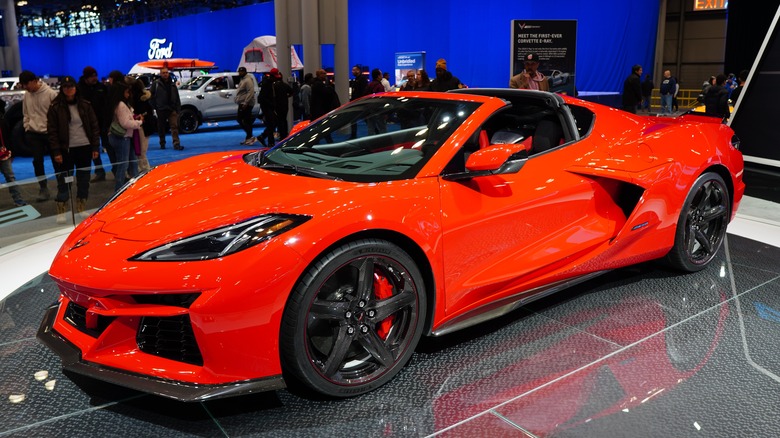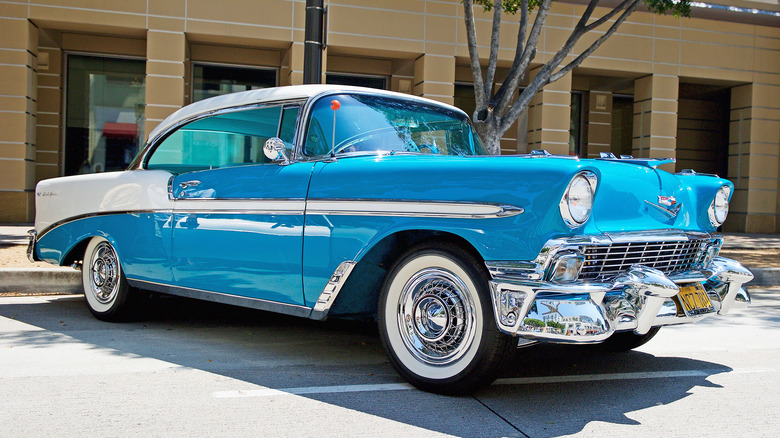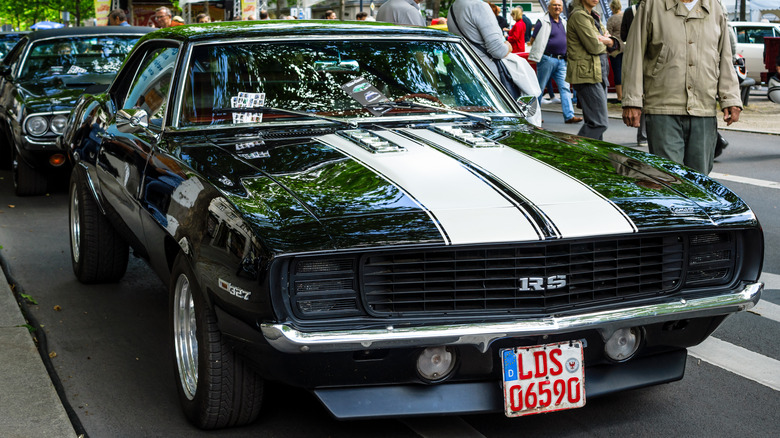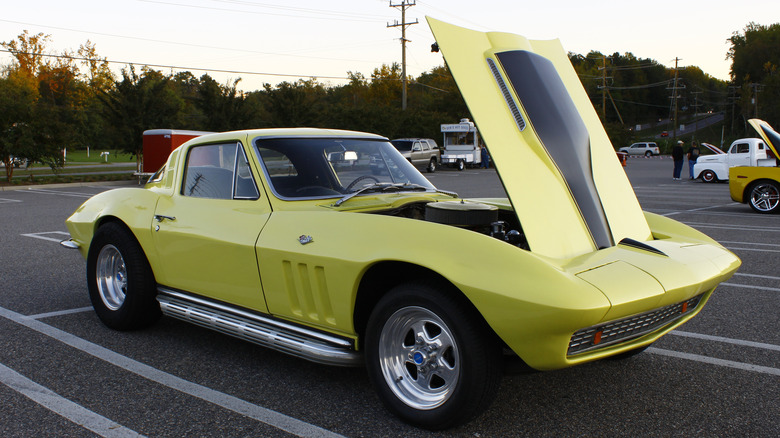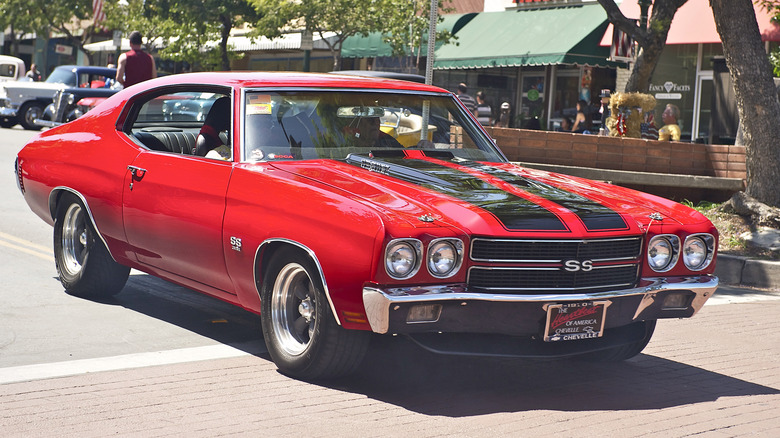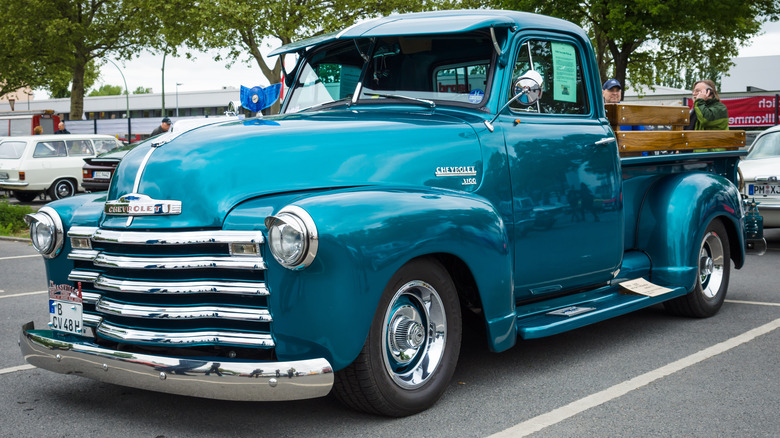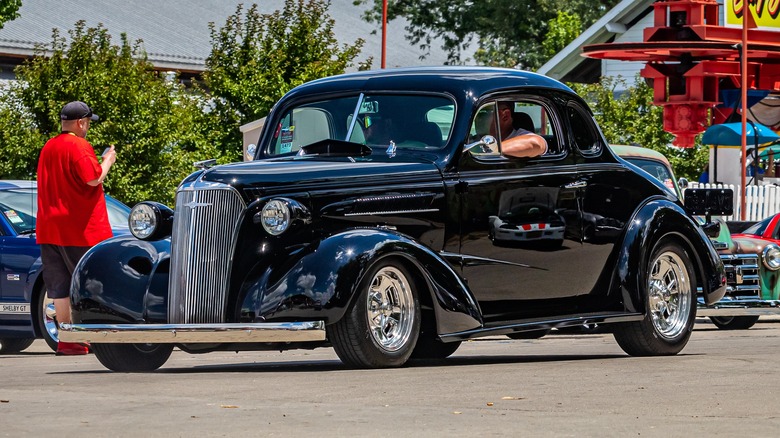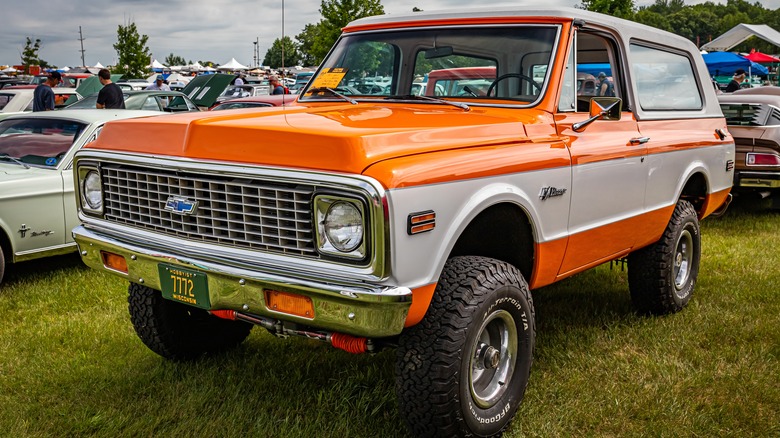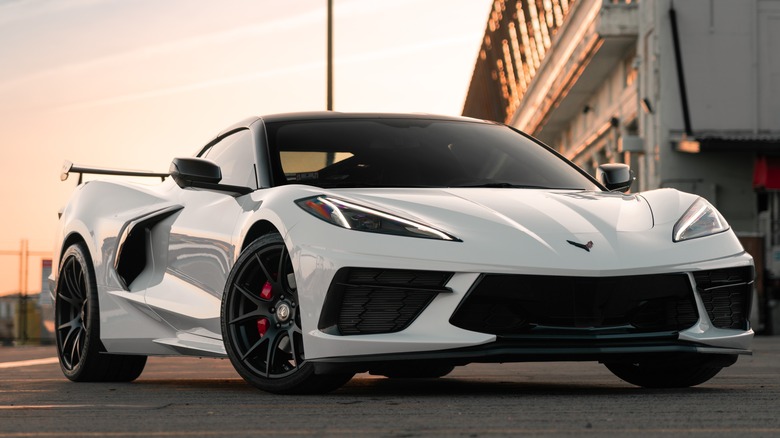8 Of The Most Beautiful Chevrolets Ever Designed
Founded in Detroit, Michigan in 1911 by Louis Chevrolet and William C. Durant, the Chevrolet Motor Company's original mission was to build cars "for every purse and every purpose." In the century-plus since, it's safe to say Chevrolet has built some iconic cars. The brand's made everything from supercars to farm trucks at all price points.
Knowing the price and purpose are nice, but anyone who pays attention to the automotive world knows that car design goes beyond that. The history of the automobile tells the story of the 20th century. Cars are the fusion of art and engineering, style and substance. They've captured the hearts and minds of millions of gearheads around the globe.
While no manufacturer hits a homer every time it gets up to the plate, it's undeniable that Chevrolet has built some great looking cars. Join us as we look at some of the most beautiful Chevrolet cars ever designed.
1956 Bel Air
A time of unparalleled prosperity for America post-World War II, the 1950s witnessed the automotive industry's ascent. Detroit's factories churned out some of history's most iconic cars, and notable among them was the 1956 Chevrolet Bel Air. The car symbolized of American automotive excellence.
Chevrolet unveiled the Bel Air for the 1950 model year, and it was an instant hit, captivating the market with 74,000 units sold. Its curved and flowing design, rounded nose, and teardrop shape set a new standard for auto production, showcasing Chevrolet's commitment to innovation and style. However, the Bel Air didn't start at its peak.
The second-generation 1955, 1956, and 1957 Chevrolet Bel Air, popularly known as "Tri-Fives," became icons of an era and remain among the most desirable classic cars. The 1956 Bel Air is smack in the middle of the second generation. The rare car that looks equally great as a sedan or a coupe, the '56 offered a quartet of engine options ranging from 3.5 to 4.6-liter V8s.
The famous two-tone paint job first became available in 1956, along with several options and design changes unavailable the previous year. Padded dashboards and seatbelts with shoulder harnesses upgraded safety, while a miracle contraption known as air conditioning improved comfort. The exterior design makes the 1956 Bel Air a timeless classic. A long head, swept-back roofline, and aggressive stance have captured the admiration of hot-rodders and restorers alike for over seventy years.
1968 Camaro RS/SS
When the first generation of Ford Mustang and Pontiac GTO shocked the market, other manufacturers jumped on the muscle car bandwagon. In an attempt to compete with the Mustang's powerful engine and compact or mid-sized chassis, Chevrolet introduced the Camaro in 1967. But it wasn't until the following year, when the golden era of muscle cars was well underway, that the car really hit it big.
The new 1968 model took its primary design cues from the '67, with subtle changes. Sidelight markers appeared on the fenders, and the vent window disappeared in favor of Chevrolet's "astro-ventilation" system. Chevrolet offered several trim packages with the '68 model, ranging from the performance-oriented Z28 down to a six-cylinder base model, but the Rally Sport/Super Sport (RS/SS) really revs our engine.
The RS/SS badge denotes a combination of performance and appearance packages combined into one classically beautiful car. A 396 cubic-inch V8 producing 325 hp towered well above the 155 hp base inline-six. Optional four-wheel disc brakes and hideaway headlights give the '68 RS/SS looks and performance that set it apart.
Chevy built about 69,000 SS or RS packages in 1968, far outstripping the rarer Z/28's 7,200 units. The '68 Camaro took a bite out of Ford's market share, but the RS/SS, with its trim packages, stands out from the other offerings that year. The Camaros from 1968 demand a premium on the auction block, and the RS/SS model is no exception.
1965 Corvette Sting Ray
Plenty of cars hit their strides in the second generation. Technical issues are ironed out, technology has advanced, and more power, comfort, and personality become available as engineers and designers seek to apply the lessons learned in the first generation. The Corvette is in its eighth generation and has produced some gorgeous automobiles during its run, but the 1965 C2 Corvette gets our nod as one of the most beautiful cars ever produced.
Debuting in 1953 as America's premier two-seater sports car, the legends of the Corvette only grew. By 1957, it was a bona fide record breaker, and Chevrolet's 283 cubic-inch engine became the first to produce a single horsepower per cubic inch. The Corvette had earned its stripes in the performance arena, but by 1963 it was time for a refresh.
By 1965, the C2 was coming into its own. Available as a hardtop or a convertible, each equally mean-looking, the 396 cubic-inch V8 put out up to 425 horsepower — an insane number by the day's standards and incredible for a car weighing a tick over 3,000 pounds.
Chevrolet designers Bill Mitchell, Larry Shinoda, and Pete Brock put their heads together to develop the XP-720 concept in 1960. The long-hooded rear cockpit style evokes thoughts of speed even when standing still. Cosmetic hood louvers speak of performance, and the mean sloped rear end seems to cut off any attempts to argue that this is one of the most beautiful cars ever produced, let alone by Chevrolet.
1970 Chevelle SS
If the Camaro wanted a slice of Ford's pony car market, the Chevelle represented the bowtie's pursuit of pure muscle. The second-generation Chevelle built on a solid start. From 1964 to 1967, Chevrolet's premier muscle nameplate had proved itself more than capable of competing with the most popular muscle cars of the day. Boxy and pugnacious, the first generation speaks to brute force, while a redesign for 1968 introduced changes that put the Chevelle on the next level.
The most significant cosmetic change occurred in the rear of the car. Gone were the straight fenders sweeping back to a traditionally flat trunk deck. In their place, a pair of muscle haunches supported a sloping, fastback-style rear end that looked like a wildcat poised to pounce.
The 1970 Chevelle offered several body styles and trim packages, including convertibles, coupes, sedans, and wagons. But the two-door hardtop Super Sport (SS) model stands as the pinnacle. Equipped with a monstrous 454 cubic-inch V8, the 1970 model year is still top choice for enthusiasts. It represents the high-water mark of the muscle craze, and it's one of the most beautiful Chevrolets ever produced.
Builders, collectors, and enthusiasts still go mad for this particular Chevelle, even producing modern iterations based on the sixth-generation Camaro.
1948 Chevrolet Advance Design Pickup
It's not just sports and muscle cars taking up the space in Chevy's most beautiful museum. The car builder has also made a reputation for itself with some of America's most beloved pickup trucks. Vintage pickup trucks are popular for restomod projects, straight restoration, and hot rod modification thanks to their classic looks and relatively simple technology. The first Chevrolet pickup hit the streets back in 1918 with the Model 490. Since then, Chevy trucks garnered a reputation for rugged reliability, but it wasn't until 1947 that they also became objets d'art.
The Advanced Design Pickup debuted in 1947 as a replacement for the Chevrolet AK series — one of the cheapest trucks Chevy ever made. As the AK series ran from 1941 to 1947, the Advance Design pickups were the first post World War II pickup refresh made by Chevrolet.
Cosmetically, the light-duty pickup remained relatively unchanged between 1948 and 1954, meaning plenty of production for the trademark bulbous fenders, sleek body panels, and a squatted stance that projects a workmanlike attention to business. Chevrolet felt the classic look of these trucks so timeless it incorporated the design cues into its retro-inspired Chevrolet SSR pickup (without much success).
Fans might be more familiar with these trucks because of their weight capacity. Half-ton trucks were called 3100, three-quarter-ton trucks were called 3600, and one-ton haulers were called 3800. Built for utility with a focus on comfort for the operator, the Advanced Design pickups won't win on the drag strip — each one got a 90 horsepower 216 cubic-inch straight 6 — but they sure won the hearts and minds of classic pickup fans.
1937 Chevy Coupe
Some cars seem to live five lifetimes. Be it as a Depression-era family hauler, souped-up, bootlegger, gangster transporter, mid-sixties hot rod, or contemporary American classic. The 1937 Chevrolet Coupe is undoubtedly one of the most iconic designs ever to come off the drafting boards at Chevy headquarters.
Flared fenders, a tall, gleaming grille, and detached bug-eyed headlights give the 1937 Chevrolet a distinctive look that speaks of an integral part of American car production history. The interesting part of the '37 Chevy is that it has taken on new life in the second-hand market multiple times. Its most significant reincarnation hit in the 1960s when gearheads began picking them out of the junkyard and kickstarting a new evolution of customization that would become known as hot-rodding.
An online search of the car shows as many, if not more, custom hot rods as straight restoration pieces. The Chevy Coupe has become a blank canvas for thousands, if not millions, of enthusiasts with a backyard shed, a welder, and an idea. While most of those hot-rods have high performance V8s slapped into them, the original iteration was far more sedate.
The original '37 Chevy had a 216-cubic inch straight six, which produced a meager 85 hp and 170 lb-ft torque. But that didn't stop them from being used as everything from daily commuters to race cars. Whether you love or hate the bow tie, there's no doubt that the Chevy Coupe is a significant piece of automotive history but the representation of an era.
1969 Chevy Blazer K5
Beauty is in the eye of the beholder, but if current used value is any indicator, plenty of beholders adore the many cool and unique features of the classic Chevrolet K5 Blazer. Utilitarian and tough, the pre-SUV SUV earned accolades as a workmanlike truck upon its debut in 1969.
The first generation of the Blazer ran from 1969 to 1972, and these seem to be the most fondly remembered and desired editions. Classic.com reports that of the three generations that ran until 1994, the original has the highest average used price of over $67,000, solidifying its status as a niche yet beloved classic Chevy.
At first glance, the K5 doesn't scream "beauty." Box-like and tall, it's not exactly a '58 Corvette or even a flowing 3100. But there's something about the K5 that makes it greater than the sum of its parts. Whether it was metal- or fibreglass-topped, or even the ultimate impractical convertible beach cruiser model, something about the Blazer gives faith to its adherents.
Facing competition from the Ford Bronco and International Harvester Scout, Chevy built the original K5 based on its existing K10 pickup. Four engine options dropped for 1969: a pair of in-line sixes (250 and 292 cubic inches) and a pair of V8s (307 and 350 cubic inches) gave the Blazer a spread of performance for buyers whether cruising the beach or pulling a stump out of the ground.
2023 Corvette
Despite its official icon status, the Corvette has taken its fair share of knocks over the years. Plenty of car fans just can't keep themselves from mentioning the words "Corvette" and "value" in the same sentences — not necessarily the adjective Chevrolet wants to be associated with its flagship sports car. The truth is the Corvette has been giving supercar companies fits, with performance on par with much more expensive vehicles at a reduced price, but it's the C8 that finally belongs in the same conversation as brands like Ferrari or Porsche.
The big change is the engine location. For decades, Porsche, Ferrari, Lamborghini, Lotus, and others have been powering their handling machines with midship engines. Back in 2020, Corvette joined their ranks, seeking better braking, weight distribution, and handling. Engineering aside, once it figured out how to squeeze a 670 horsepower V8 (2023 Z06) behind the driver, it wrapped it up in a body that looks like it could take off from the deck of the USS Ronald Reagan.
Three years into the eighth generation, the supercar 'Vette has only gotten meaner and more radical looking. Combining racy curves with aggressive razor-sharp lines and a pair of air intakes that look like they could fuel a jet engine, there's no question the 2023 Corvette is one of the most advanced and gorgeous cars Chevy has ever designed.
